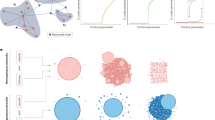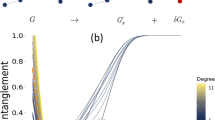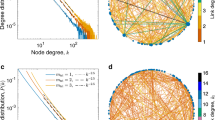Error and attack tolerance of complex networks (original) (raw)
- Letter
- Published: 27 July 2000
Nature volume 406, pages 378–382 (2000)Cite this article
- 54k Accesses
- 7071 Citations
- 89 Altmetric
- Metrics details
A Corrigendum to this article was published on 25 January 2001
Abstract
Many complex systems display a surprising degree of tolerance against errors. For example, relatively simple organisms grow, persist and reproduce despite drastic pharmaceutical or environmental interventions, an error tolerance attributed to the robustness of the underlying metabolic network1. Complex communication networks2 display a surprising degree of robustness: although key components regularly malfunction, local failures rarely lead to the loss of the global information-carrying ability of the network. The stability of these and other complex systems is often attributed to the redundant wiring of the functional web defined by the systems' components. Here we demonstrate that error tolerance is not shared by all redundant systems: it is displayed only by a class of inhomogeneously wired networks, called scale-free networks, which include the World-Wide Web3,4,5, the Internet6, social networks7 and cells8. We find that such networks display an unexpected degree of robustness, the ability of their nodes to communicate being unaffected even by unrealistically high failure rates. However, error tolerance comes at a high price in that these networks are extremely vulnerable to attacks (that is, to the selection and removal of a few nodes that play a vital role in maintaining the network's connectivity). Such error tolerance and attack vulnerability are generic properties of communication networks.
This is a preview of subscription content, access via your institution
Access options
Subscribe to this journal
Receive 51 print issues and online access
$199.00 per year
only $3.90 per issue
Buy this article
- Purchase on SpringerLink
- Instant access to full article PDF
Prices may be subject to local taxes which are calculated during checkout
Additional access options:
Similar content being viewed by others



Growing scale-free simplices
Article Open access 05 March 2021
References
- Hartwell, L. H., Hopfield, J. J., Leibler, S. & Murray, A. W. From molecular to modular cell biology. Nature 402, 47–52 (1999).
Article Google Scholar - Claffy, K., Monk, T. E. et al. Internet tomography. Nature Web Matters [online] (7 Jan. 99) 〈http://helix.nature.com/webmatters/tomog/tomog.html〉 (1999).
- Albert, R., Jeong, H. & Barabási, A.-L. Diameter of the World-Wide Web. Nature 401, 130–131 ( 1999).
Article ADS CAS Google Scholar - Kumar, R., Raghavan, P., Rajalopagan, S. & Tomkins, A. in Proc. 9th ACM Symp. on Principles of Database Systems 1–10 (Association for Computing Machinery, New York, 2000).
Google Scholar - Huberman, B. A. & Adamic, L. A. Growth dynamics of the World-Wide Web. Nature 401, 131 (1999).
Article ADS CAS Google Scholar - Faloutsos, M., Faloutsos, P. & Faloutsos, C. On power-law relationships of the internet topology, ACM SIGCOMM '99. Comput. Commun. Rev. 29, 251–263 (1999).
Article Google Scholar - Wasserman, S. & Faust, K. Social Network Analysis (Cambridge Univ. Press, Cambridge, 1994).
Book Google Scholar - Jeong, H., Tombor, B., Albert, R., Oltvai, Z. & Barabási, A.-L. The large-scale organization of metabolic networks. Nature (in the press).
- Erdös, P. & Rényi, A. On the evolution of random graphs. Publ. Math. Inst. Hung. Acad. Sci. 5, 17–60 (1960).
MathSciNet MATH Google Scholar - Bollobás, B. Random Graphs (Academic, London, 1985).
MATH Google Scholar - Watts, D. J. & Strogatz, S. H. Collective dynamics of ‘small-world’ networks. Nature 393, 440– 442 (1998).
Article ADS CAS Google Scholar - Zegura, E. W., Calvert, K. L. & Donahoo, M. J. A quantitative comparison of graph-based models for internet topology. IEEE/ACM Trans. Network. 5, 770–787 (1997).
Article Google Scholar - Williams, R. J. & Martinez, N. D. Simple rules yield complex food webs. Nature 404, 180 –183 (2000).
Article ADS CAS Google Scholar - Maritan, A., Colaiori, F., Flammini, A., Cieplak, M. & Banavar, J. Universality classes of optimal channel networks. Science 272, 984– 986 (1996).
Article ADS CAS Google Scholar - Banavar, J. R., Maritan, A. & Rinaldo, A. Size and form in efficient transportation networks. Nature 399, 130–132 (1999).
Article ADS CAS Google Scholar - Barthélémy, M. & Amaral, L. A. N. Small-world networks: evidence for a crossover picture. Phys. Rev. Lett. 82, 3180–3183 ( 1999).
Article ADS Google Scholar - Barabási, A.-L. & Albert, R. Emergence of scaling in random networks. Science 286, 509– 511 (1999).
Article ADS MathSciNet Google Scholar - Barabási, A.-L., Albert, R. & Jeong, H. Mean-field theory for scale-free random networks. Physica A 272, 173–187 ( 1999).
Article ADS Google Scholar - Redner, S. How popular is your paper? An empirical study of the citation distribution. Euro. Phys. J. B 4, 131– 134 (1998).
Article ADS CAS Google Scholar - Lawrence, S. & Giles, C. L. Accessibility of information on the web. Nature 400, 107– 109 (1999).
Article ADS CAS Google Scholar - Milgram, S. The small-world problem. Psychol. Today 2, 60–67 (1967).
Google Scholar - Bunde, A. & Havlin, S. (eds) Fractals and Disordered Systems (Springer, New York, 1996).
Book Google Scholar - Paxson, V. End-to-end routing behavior in the internet. IEEE/ACM Trans. Network. 5, 601–618 ( 1997).
Article Google Scholar - Adamic, L. A. The small world web. Lect. Notes Comput. Sci. 1696, 443–452 (1999).
Article Google Scholar
Acknowledgements
We thank B. Bunker, K. Newman, Z. N. Oltvai and P. Schiffer for discussions. This work was supported by the NSF.
Author information
Authors and Affiliations
- Department of Physics, 225 Nieuwland Science Hall, University of Notre Dame, Notre Dame, 46556, Indiana, USA
Réka Albert, Hawoong Jeong & Albert-László Barabási
Authors
- Réka Albert
- Hawoong Jeong
- Albert-László Barabási
Corresponding author
Correspondence toAlbert-László Barabási.
Rights and permissions
About this article
Cite this article
Albert, R., Jeong, H. & Barabási, AL. Error and attack tolerance of complex networks.Nature 406, 378–382 (2000). https://doi.org/10.1038/35019019
- Received: 14 February 2000
- Accepted: 07 June 2000
- Issue Date: 27 July 2000
- DOI: https://doi.org/10.1038/35019019